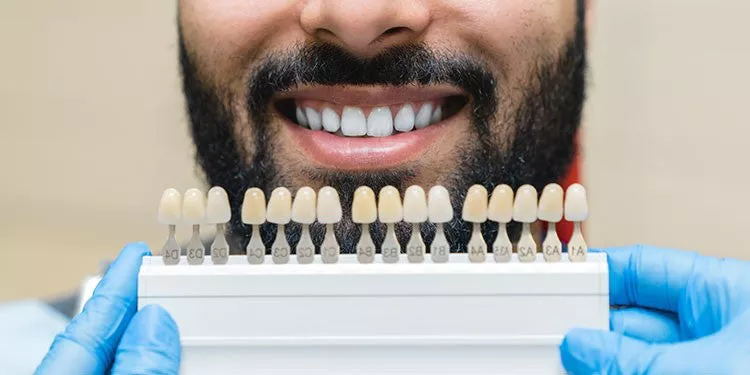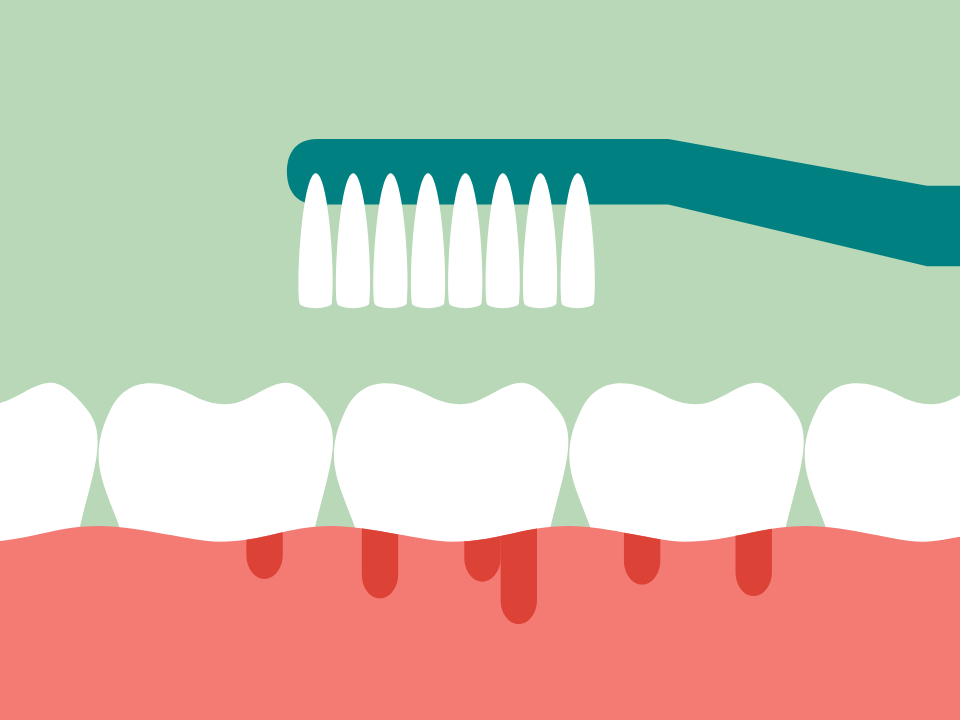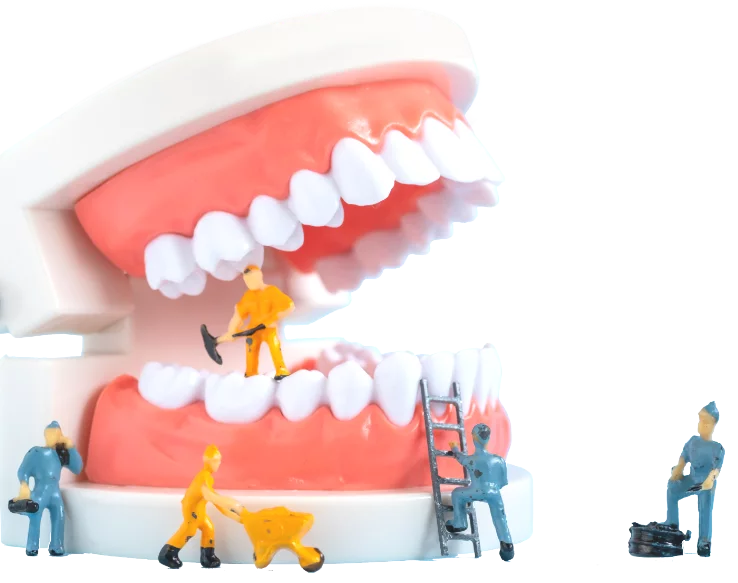In a world with thousands of pictures documenting your every experience, your smile is displayed on a global stage through social media, online work meetings, and video calls. Having a bright smile to greet the world is a natural desire for most people.
Whether you're dealing with stains, chips, or uneven teeth—or just want a confidence boost—this guide breaks down the most popular types of veneers, how much they cost (with and without insurance), and what to expect in terms of longevity, pros, and maintenance.
Different Types of Veneers and Cost
Veneers are thin covers placed over the front of your teeth to improve appearance, fix minor flaws, and boost overall smile aesthetics. Veneers can give you a real reason to smile as you show off your beautiful, new teeth and face the world with a glowing confidence. Deciding between the different types of veneers and weighing the cost of each can help you determine which kind will be the best fit for you. If would like to learn about the step-by-step process of getting veneers placed, read our article.
| Feature | Details |
|---|---|
| Type 1 | Porcelain Veneers |
| Benefits | ✨ Natural look, 🛡️ stain-resistant, 🎯 durable |
| Durability | ⏳ 8–20 years |
| Cost | 💵 $500–$2,500 per tooth |
| Type 2 | Composite Veneers |
| Benefits | 💰 Affordable, ⏱️ one visit, 🪄 direct application |
| Durability | ⌛ 5–7 years |
| Cost | 💸 $250–$1,500 per tooth |
| Type 3 | Lumineers |
| Benefits | 🪞 Ultra-thin, 🦷 minimal prep, 😁 natural look |
| Durability | 📆 Up to 20 years |
| Cost | 💳 $800–$2,000 per tooth |
| Type 4 | Removable Veneers |
| Benefits | 🎭 Temporary, 🔄 non-invasive, 🧳 travel-friendly |
| Durability | 📆 Not long as they are not made for long-term or even daily usage |
| Cost | 💲 As low as $25, not covered by insurance |
If you're interested in improving your smile with veneers, the first step is scheduling a consultation with a cosmetic dentist.
If you're not ready to schedule a consultation and want to learn more, see full article, or chat with a cosmetic dentist to explore options. There are different types of veneers to consider, such as the material used, durability, and price. How much do full-mouth veneers cost per tooth? You can weigh the price difference between the various types, as well as the cost of full mouth veneers to the cost of veneers per tooth. Learn more below.
What Are Porcelain Veneers?
Key Things to Know:
Natural look & stain-resistant — lasts up to 20 years.
Custom fit & durable, but expensive and permanent.
Insurance rarely covers — savings up to $1,000/tooth if eligible
For the most natural-looking veneers, porcelain mimics the look of real teeth while actually being made out of a stronger material. Porcelain veneers also last the longest when compared to other kinds of veneers. With durability coupled with good oral hygiene, porcelain veneers can last for as long as 20 years. By removing a thin layer of enamel from the front of the teeth, the dentist will bond a porcelain overlay to the front surface, making a permanent, custom-shaped, natural-looking smile. Porcelain has a translucent quality similar to a tooth’s enamel, so the overall effect of porcelain veneers looks dazzling yet natural.
| Feature | Porcelain Veneers |
|---|---|
| Benefits | ✨ Natural look, 🛡️ stain-resistant, 🎯 durable |
| Durability | ⏳ 8–20 years |
| Cost | 💵 $500–$2,500 per tooth |
Pros of Porcelain Veneers
- Custom made for your mouth
- Stain-resistant
- Very strong and durable
- Smooth texture
- Very natural appearance
- Long-lasting, typically eight to 20 years
Cons of Porcelain Veneers
- Expensive, $500 to $2500 per tooth
- The procedure takes up to three visits
- Irreversible and invasive procedure
Cost With & Without Insurance
How much do veneers cost with insurance? When it comes to whether or not insurance covers porcelain veneer costs, it is difficult to give a definite answer because there are so many different variables. Unless your dental insurance covers cosmetic dentistry, you will most likely have to provide a medical reason for the veneers. Health insurance rarely covers veneers unless it is somehow connected to a medical necessity relating to your body’s overall health.
What Are Composite Veneers?
Key Things to Know:
More affordable & less invasive — $250–$1,500 per tooth.
Shorter lifespan (5–7 years) and prone to stains.
Can be done in one visit, but results depend on dentist’s skill.
Composite veneers, also called direct veneers, involve a very different process than porcelain veneers. Composite veneers are made of a resin, or glue, that is fitted onto a cleaned, dried, and roughed up the tooth and spread around by the dentist until the desired look is achieved. The same material that dentists use for tooth-colored fillings is used to design composite veneers. This process can be lengthy as the veneer is created and shaped directly on each tooth.
Composite veneers, though more easily stained, can be half the price of porcelain veneers and can create a fresh, new look for your smile. Although composite veneers offer a more appealing price and can be reversible if layers of the tooth are not removed, they, unfortunately, only last a little more than five years. The overall appearance of composite veneers is nice, but they do not look as natural as porcelain veneers. Finding a very experienced cosmetic dentist who is skilled in creating composite veneers will give you a much better chance of a natural look.
| Feature | Composite Veneers |
|---|---|
| Benefits | 💰 Affordable, ⏱️ one visit, 🪄 direct application |
| Durability | ⌛ 5–7 years |
| Cost | 💸 $250–$1,500 per tooth |
Pros of Composite Veneers
- Durable for a temporary treatment
- Less invasive procedure. Ask your dentist how much enamel will be removed. Some do not take off any but rather add acid to rough up the enamel
- An acceptable appearance
- Does not affect the gum tissue in most cases
- Easily repaired if chipped or broken
- Usually completed in only one appointment
- Last between five to seven years
- Less expensive than porcelain veneers, $250 to $1500 per tooth
Cons of Composite Veneers
- Do not last as long as porcelain veneers
- Prone to staining
- Long time in the chair
- Results vary and depend heavily on the skills of the cosmetic dentist
Cost With & Without Insurance
Click here to learn about our Smile Generation Dental Discount Plan
What Are Lumineers?
Key Things to Know:
Thin, natural-looking, and reversible, but less durable.
Costs $800–$2,000 per tooth, slightly less than porcelain.
Rarely covered by insurance, even with cosmetic coverage.
Even with porcelain veneers, there can be differences depending on the brand of veneers you get through your dentist. Lumineers are a brand of porcelain veneers that use a very thin porcelain laminate material. What sets Lumineers apart from other kinds of porcelain veneers is that when prepping the tooth, less enamel is removed from the surface before bonding the Lumineers to the tooth. Because of the thinness of the Lumineers, though still durable and long-lasting, they are not as strong as regular porcelain veneers and have the potential to be cracked or chipped. Lumineers can last more than 20 years but can also be removed from the teeth without permanent damage. They are very similarly priced as porcelain veneers, although slightly less expensive.
| Feature | Lumineers |
|---|---|
| Benefits | 🪞 Ultra-thin, 🦷 minimal prep, 😁 natural look |
| Durability | 📆 Up to 20 years |
| Cost | 💳 $800–$2,000 per tooth |
Pros of Lumineers
- Lasting over 20 years
- Natural-looking
- Reversible
- Can be less expensive than porcelain veneers
Cons of Lumineers
- More prone to cracking and chipping
- Expensive: $800-$2000 per tooth
- Less chance of insurance coverage
Cost With & Without Insurance
What Are Removable Veneers (Temporary Veneers)?
Key Things to Know:
Instant, low-cost smile boost — prices start as low as $25.
Fully reversible, but not for daily or long-term use.
Not covered by insurance and may cause gum irritation over time.
For those who want an instantly brighter, straighter smile, wearing removable veneers may be the right decision. Temporary veneers are quite easy on your wallet, don’t involve any lengthy process, and are completely reversible. Removable or temporary veneers fit over your teeth, improving the color and appearance. There are many different kinds of removable veneers, and some can be made by taking an impression of your teeth to ensure a good fit. However, they do not have as natural of a look as porcelain veneers or composite veneers. Removable veneers can irritate your gums after hours of wear and are not made for long-term or even daily use.
| Feature | Removable Veneers |
|---|---|
| Benefits | 🎭 Temporary, 🔄 non-invasive, 🧳 travel-friendly |
| Durability | 📆 Not long as they are not made for long-term or even daily usage |
| Cost | 💲 As low as $25, not covered by insurance |
Pros of Removable Veneers
- Instant smile transformation
- Inexpensive.
- You can eat with them on
Cons of Removable Veneers
- Temporary
- Not made for daily use
- Can cause plaque build-up or irritate gums when worn long-term
- Provide no protection for broken, cracked, or chipped teeth
Cost With & Without Insurance
Because removable veneers are so inexpensive, even as low as $25, and have no added oral hygienic advantage, they are not covered by insurance. As such, they are not recommended as a significant solution for tooth improvement.
Find a Cosmetic Dentist Near Me
If you are looking for a skilled, experienced dentist to give you the glamorous smile you have dreamed of through porcelain or composite veneers, use the Find A Dentist Tool through Smile Generation today to learn more about the types of veneers and their cost.
Find your trusted, local dentist today!
Veneer Types and Cost FAQs
Veneers typically range from $250 to $2,500 per tooth, depending on the type:
Porcelain veneers: $500–$2,500 per tooth
Composite veneers: $250–$1,500 per tooth
Lumineers: $800–$2,000 per tooth
Removable veneers: as low as $25
The article covers four main types:
Porcelain veneers – natural-looking, durable, stain-resistant
Composite veneers – less expensive, done in one visit, shorter lifespan
Lumineers – ultra-thin porcelain, reversible, slightly less durable
Removable veneers – inexpensive, temporary, not for daily use
Coverage is rare and depends on medical necessity. If approved:
Porcelain: up to $1,000 off per tooth, with out-of-pocket around $1,400
Composite: $550–$850 per tooth
Lumineers: typically $1,400 per tooth
Removable: Not covered by insurance
Without insurance, costs generally fall into these ranges:
Porcelain: $500–$2,500 per tooth
Composite: similar to insured costs, $250–$1,500 per tooth
Lumineers: $800–$2,000 per tooth
Removable: as low as $25
Sources
- American Association of Orthodontists. (2022, March 1). Adults’ teeth can be moved too. Accessed April 30, 2025.
- American Dental Association. (2022, March 1). Veneers. Mouth Healthy. Retrieved from https://www.mouthhealthy.org/all-topics-a-z/veneers/. Accessed April 30, 2025.
Smile Generation blog articles are reviewed by a licensed dental professional before publishing. However, we present this information for educational purposes only with the intent to promote readers’ understanding of oral health and oral healthcare treatment options and technology. We do not intend for our blog content to substitute for professional dental care and clinical advice, diagnosis, or treatment planning provided by a licensed dental professional. Smile Generation always recommends seeking the advice of a dentist, physician, or other licensed healthcare professional for a dental or medical condition or treatment.









